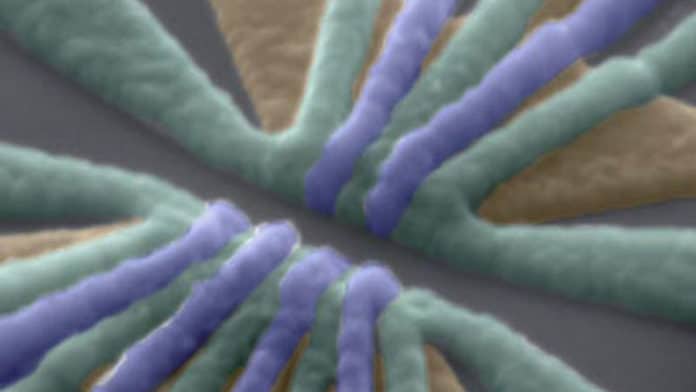Scientists achieved triple qubit entanglement
28/09/2021
False-colored scanning electron micrograph of the device. The purple and green structures represent the aluminium gates. Six RIKEN physicists succeeded in entangling three silicon-based spin qubits using the device. © 2021 RIKEN Center for Emergent Matter Science
Scientists at RIKEN have recently realized three-qubit entanglement in a fully controllable array of spin qubits in silicon. This highlights the potential of spin qubits for realizing multi-qubit quantum algorithms.
To do so, scientists increased the number of silicon-based spin qubits that can be entangled from two to three.
Silicon quantum dots, also known as tiny blobs of silicon, are highly attractive for realizing qubits. These qubits have long coherence times, high-fidelity electrical control, high-temperature operation, and great potential for scalability.
To connect several silicon-based qubits, it is essential to entangle more than two qubits.
To do so, scientists initialized and measured a three-qubit array in silicon with high fidelity. They also combined the three entangled qubits in a single device.
Seigo Tarucha from the RIKEN said, “This demonstration is a first step toward extending the capabilities of quantum systems based on spin qubits. A two-qubit operation is good enough to perform fundamental logical calculations. But a three-qubit system is the minimum unit for scaling up and implementing error correction.”
The newly developed device- composed of a triple quantum dot on a silicon/silicon-germanium heterostructure- is controlled through aluminum gates. Each quantum dot can host one electron, whose spin-up and spin-down states encode a qubit. An on-chip magnet generates a magnetic-field gradient that separates the resonance frequencies of the three qubits so that they can be individually addressed.
Scientists started with entangling two of the qubits by implementing a two-qubit gate. By combining the third qubit and the gate, they realized three-qubit entanglement with a fidelity of 88%.
Tarucha said, “This demonstration is just the beginning of an ambitious course of research leading to a large-scale quantum computer. We plan to demonstrate primitive error correction using the three-qubit device and fabricate devices with ten or more qubits. We then plan to develop 50 to 100 qubits and implement more sophisticated error-correction protocols, paving the way to a large-scale quantum computer within a decade.”
Source: https://bit.ly/3AHUQii, via Tech Explorist

